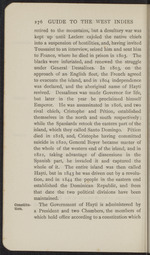| 1 |
 |
“...WEST INDIES
concluded, that our little leakie companion,” a
small vessel which had been keeping up with
them, “ was buried.” Off the islands called “ the
deserts,” a sail was sighted which “ we doubted was
a Turke”; and “made us putt ourselves in a posture
of defence, and the next morning, findeing that he
had chased us all night ... we prepared all things
for a fight, and continued in that posture all the
day and night.” On arriving at Madeira they were
“ verry neare loosing our shippe, the master being
unacquainted, and comeing too boldely in near
the shoar, in a daingerous place.” On Tuesday,
the 18th, they crossed the Tropic of Cancer, and
were much diverted by the flying fish, “which,
though common at sea, may be a subject of wonder
to such as are home-bred . . . they fly in whole
shoales, but not very farre, for no sooner are
their wings dry, but they drop into theire element,
the water. It is usual for them to fly into the
shipps. We had one or two come on board our
vessell.” On...”
|
|
| 2 |
 |
“...antiquity.
Masonic visitors are, of course, welcomed at
these lodges in true masonic spirit.
Language. It may seem superfluous to add a paragraph
regarding language, but the writer is prompted
to do so by the many inquiries he has received
from intending visitors to the West Indies, who
seem to think that the islands are peopled by
savages speaking unknown tongues. On the
contrary, the inhabitants are mostly English-
speaking. The mode of speech attributed to
them in books, such as “massa” for “Master,”
&c., does not really adequately describe their
style, which owes its piquancy to the drawling
and sing-song method of delivery which is ac-
centuated to a marked degree in Barbados, where
even many of the whites are infected with it.
In the islands which have been in the possession
of France, such as Dominica and St. Lucia, the
^ negroes speak a rather bewildering French patois,
though they understand French. A peculiarity
in Montserrat is the Irish brogue which the
negroes acquired from the...”
|
|
| 3 |
 |
“...182 GUIDE TO THE WEST INDIES
experimental plots. There is also a small Stock
Farm attached to it, where pedigree animals are
kept. The pupils of the school, about twenty-five
in number, receive a sound education in practical
agriculture and applied sciences free of cost to
their parents. Visitors can inspect this institu-
tion also on application to the resident master in
charge. Both the Cotton Ginnery and Agricultural
School are under the control of the Imperial
Department of Agriculture.
Soufrière. If time Permits> an expedition should be made
to the Soufrière, the volcano (3500 feet high)
situated at the northern end of the island, which
suddenly burst into violent eruption on 7th May
1902, a day in advance of La Montagne Pelée in
Martinique, after being quiescent since 1812, and
continued in a state of activity until March 1903.
The following account of the eruption, which re-
sulted in the loss of 2000 lives, was given by the
Rev. J. H. Darrell of Kingstown, who was an
eye-witness...”
|
|
| 4 |
 |
“...island, and in 1804 independence
was declared, and the aboriginal name of Hayti
revived. Dessalines was made Governor for life,
but later in the year he proclaimed himself
Emperor. He was assassinated in 1806, and two
rival chiefs, Cristophe and Pétion, established
themselves in the north and south respectively;
while the Spaniards retook the eastern part of the
island, which they called Santo Domingo. Pétion
died in 1818, and, Cristophe having committed
suicide in 1820, General Boyer became master of
the whole of the western end of the island, and in
1822, taking advantage of dissensions in the
Spanish part, he invaded it and captured the
whole of it. The entire island was then called
Hayti, but in 1843 he was driven out by a revolu-
tion, and in 1844 the people in the eastern end
established the Dominican Republic, and from
that date the two political divisions have been
maintained.
The Government of Hayti is administered by
a President and two Chambers, the members of
which hold office...”
|
|
